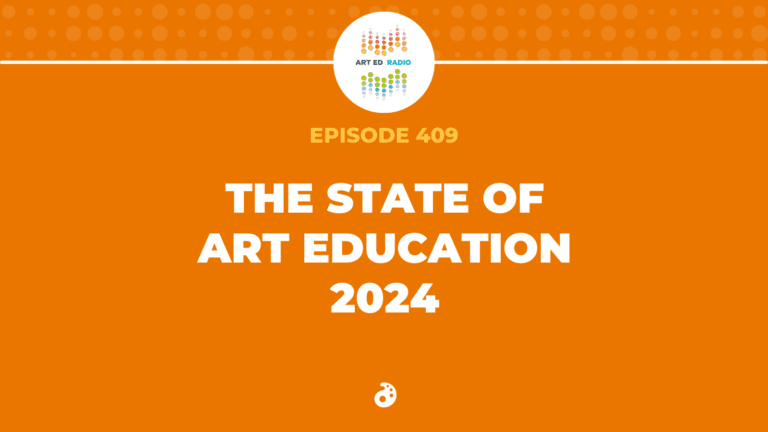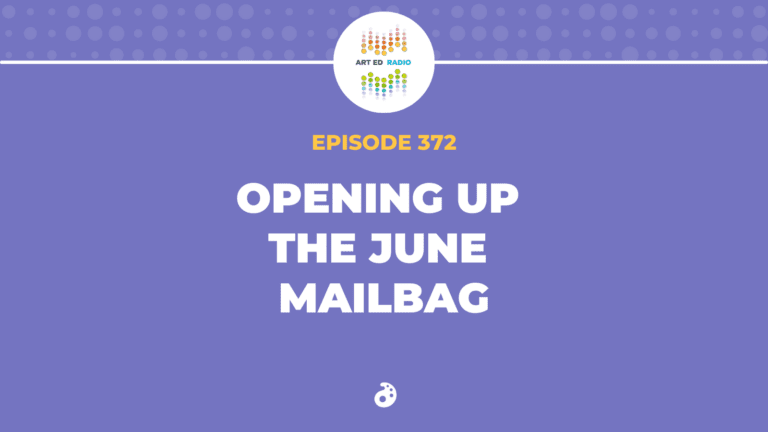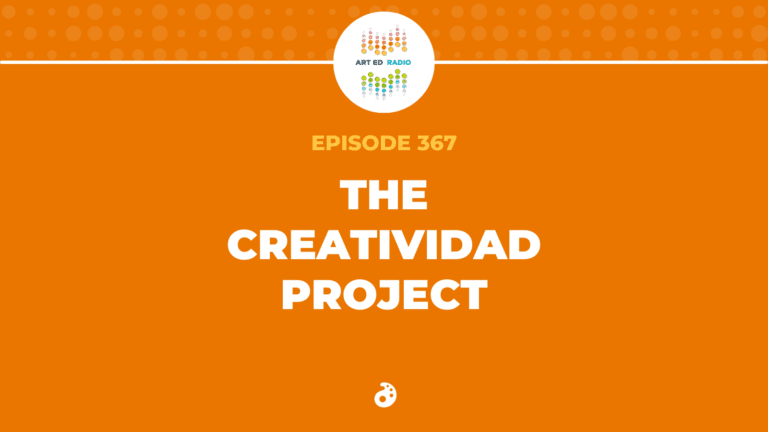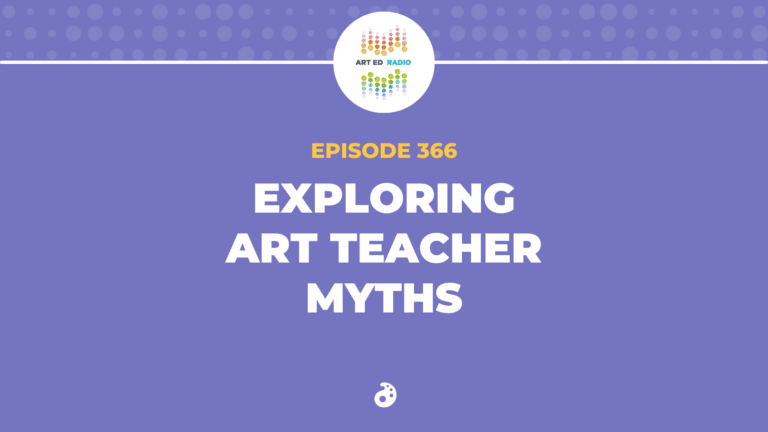We all know about the power of the arts, and in this episode, Andrew looks really closely at how we can use the arts to build culture and turn around schools. Sarah Dougherty, who is part of the Turnaround Arts Initiative with the Des Moines Public Schools, joins Andrew to talk about her experience with these exact topics. They discuss how to become more creative and intentional with collaboration (10:00), how small changes can make a big impact on your school’s culture (12:45), and the need for patience when you are looking for change. (14:30). Full episode transcript below.
Resources and Links:
- Check out the TASK party that Sarah mentioned
- The Des Moines Public Schools Turnaround Arts Program
- See all of Sarah’s AOE articles
- Andrew mentioned AOE’s new Professional Development subscription service, Art Ed PRO

Transcript
Welcome to Art Ed Radio, the podcast for art teachers. This show is produced by the Art of Education and I’m your host, Andrew McCormick.
So, not too long ago, I was able to sit in on a round of interviews for a new art teacher in my district. I had some really interesting insights into the whole process, but weirdly, one of the things that became apparent is just how similar school districts are. My principal and I had some really interesting conversations about the state of education, not just in our own building, but big picture education.
The thing that every applicant talked about is how school culture and school morale is so important and an issue for them this year. I’m not sure if it’s that being a teacher is just a really tough job and everyone likes to complain. I’m not sure that I’ve worked a year in my career in a school where school culture or morale wasn’t an issue. “It needs to get better. It’s not like it used to be. If only so-and-so did such-and-such, then we’d have a better climate and culture.”
I know I’ve been guilty of this. But I got to confess, I’m so tired of complaining about school culture and morale. It’s hollow at best and, most likely, it’s pretty darn toxic. Maybe part of the reason why your building doesn’t have a great culture and low morale is because everyone’s just sitting around flapping their gums about low morale and not doing anything about it. So, I’m done doing this. Voicing complaints and grievances without actionable solutions, it’s just whining, and I’m over it.
Okay. So, now that I’ve got that out of my system, I’m taking a proactive approach to change. What can we do about it? How can we change a school’s culture and climate? I want to start doing things about that. Now, I would be a charlatan if I came on here and said that all a school has to do to change its culture and climate is embrace the arts. But it actually does sound like a pretty good first step to me.
Just recently, I was at AOE headquarters in lovely Osage, Iowa and I got a chance to sit down, literally, with my good friend Sarah Dougherty from the Des Moines Public School System. Sarah has been overseeing Turnaround Arts: Des Moines, a program for, I believe, about four years now. Who better to talk to about this amazing power that art has to be an agent of positive change for your building or your district than Sarah?
If you haven’t seen yet, the Art of Ed just rolled out Art Ed Pro, which is the new awesome way to get art teacher-specific professional development. It’s a library filled with video trainings, hands-on tutorials, amazing downloadable and printable resources, and so much more. It’s like an on demand, personalized learning service. What I think is so great about it, it’s PD when you need it and how you need it. It can be tailored to your strengths or your growth areas and it’s something that brand new teachers, or even seasoned veterans out there, would get a ton out of.
So, I filmed learning packs on design thinking, which was a lot of fun, and making art with unexpected materials, which will be released soon. If you like hearing from Sarah Dougherty on today’s episode, you should definitely check out her Learning Pack on formative assessment strategies, which she is just the absolute perfect person for. So, basically, Art Ed Pro gets into just about every topic in art ed and there are some learning packs being released every single month. You can try a free trial or subscribe at ArtEdPro.com.
So, let’s get to Sarah’s interview that we conducted, actually, in the middle of a field while visiting AOE headquarters. Maybe if you listen closely, you’ll hear some lovely natural ambiance.
So, we’re talking about turning around a school climate and culture through the arts. So, I’m going to, Sarah, give you a really simple, obvious question as you’ve got tons of experience doing this. Number one, how do you see the arts having a unique ability to turn around a school’s culture? Then secondly, and maybe this is up front, why don’t you share a little bit of your experience in doing this with our listeners?
Sarah: Sure. So, the arts really have a unique power because it’s something we all connect to on varying levels. That includes the visual arts and music and performing arts. But it’s something that’s a shared piece of common humanity. So, when you think about a school and what you’re trying to do and school improvement, you’re trying to shift all these disparate groups all moving in the same direction, which is for academic achievement and for college and career readiness, even at the elementary level.
So, the arts just provide that common positive platform that people can really rally around. Parents, students, teachers, it’s like that feelgood stuff that also gets down deeper. I think that’s what the arts have the opportunity to do for a school. We’ve done some really great things in our schools that require teachers and kids and parents to work together in a way that wasn’t always possible in a much more siloed system.
That’s really been one of our big success points is all of this new collaboration where people come to the table with tremendous professional expertise and they start to use that expertise together to build an experience that’s much more meaningful for students. So, for instance, art teacher comes together with a science teacher and they work together to provide kids a rich, engaging instructional task that makes the learning come alive, both in the arts and in the the content area.
It’s not just in the classroom. Things like an art show where we know we have parents show up and asking ourselves, or even our school administration, what needs can we serve? I have 400 parents showing up for the art school. What’s the other message they need to hear besides, “Your kid is learning an awesome amount of stuff in art.” If we can come together and come to that common idea of where we want to go as a school and think about the arts as a way to get there, some great things happen. Those are some of the classes we’ve seen in Des Moines Public Schools.
Andrew: So, you’re doing a kind of up on high, big, national program in Des Moines Public Schools that is at the elementary level, middle school level, is it K-12? Maybe talk a little bit about that.
Sarah: Sure. It’s K-8. We have it in five schools, four elementaries and the middle school that it feeds into. What we really want to develop is a pipeline to success through the arts. That was important for us because we know high schools have strong arts programs because they serve a different purpose in those schools. It’s about getting credits to graduate and they needs those elective credits. They don’t really serve that kind of purpose in elementary and middle.
So, having it in elementary and middle school in Des Moines was a great opportunity for us to create these pathways. So, if I’m in Drama Club or in Art Club or I’m loving art in elementary school, I can be secure in knowing that it’s going to happen for me in middle school and I know for sure my high school has it. So, if provides kids a really hopeful pathway, kids who really connect with that kind of learning, and keeps them in school and engaged.
Andrew: So, maybe you can talk about this then. What types of specific things can the arts do to turn around a school’s performance and culture? Maybe give us some examples of some projects, programs, ideas that you guys are doing in the Des Moines Public Schools that before you guys focused on turning around through the arts that you weren’t doing before then.
Sarah: One thing I would say that we do a lot of is some legacy art pieces, meaning that a grade level will collaborate to create a piece of art and leave that behind as a message of hope and a message of the importance of school for the kids who come behind them. So, we have reading nooks that have been painted and created in our elementary libraries. We have little free libraries outside of our school. We have peace pole gardens. All of those are focused on this greater idea of giving kids a hopeful message and keeping them in school. That wasn’t happening before.
Another thing that’s happening is these really rich collaborations around using arts-based strategy in the core classroom. So, having those teachers work together and provide time for that has made a tremendous difference because that time isn’t always easy to find. But when we intentionally find it, we’ve been unfolding some really great instructional things.
For instance, reader’s theater, I think, is pretty familiar to a lot of classroom teachers. But what if we have kids writing the performances they’re going to put on? What if we have kids designing costumes for it and creating them? So, taking all of those things up a level. I think that’s a place where you can build upon and honor all of the work that art teachers and music teachers and classroom teachers have done. But when you come together, you lift it up in a way that hasn’t been done before.
Andrew: So, I want to close, not yet, but I know I want to ask you at the end a big picture, pros and cons, struggles and triumphs. But I hear a lot of collaboration and cross-curricular and people working together. I hope I don’t steal your thunder on the question at the end. But was that hard for you guys to, as a building, as a district, to come together? I can envision some listeners listening to this and saying, “Well, that would be great, but I can’t find the time or the personnel who want to do this.” Maybe speak a little bit about how that was able to take shape.
Sarah: Yeah. I think we have to be more creative about how and when we collaborate. Digital platforms make scheduling barriers nonexistent. You can create yourself a digital space. I think the other pitfall that you can avoid is trying to take on the whole school or a whole grade level. Find a coalition of the willing. Sometimes, that’s just one other teacher, and that’s just one lesson. I think if you look at transforming an entire school, yeah, that’s a big project and there’s going to have to be some big picture systems thinking around how you intentionally make that work and make those collaboration times possible.
But if you start as one person, finding one willing partner to lead with you, and then being creative with the times that you can collaborate, maybe it’s a lunch collaboration. Maybe it’s a person you have recess duty with. Maybe you just start a little two person blog where you’re posting your ideas and exchanging that way. It can be done and it can be done without huge disruption to schedules and other kinds of collaboration times.
Andrew: That leads me to switching up a little bit because you guys in Des Moines have been able to do this under a program, Turnaround Arts, and a whole way of thinking. I’m just imagining listeners out there who are saying to themselves, “Well, I’m in a smaller community. I’m a one person department. Maybe I’m even a one person department who teaches K-12. I don’t have the curriculum director, the admin support, or guidance to do this.”
So, I’m wondering from your expertise, what are some things that someone like that, someone who’s a singleton department, what are some things that they could be doing next year to start to use the arts to turn around culture and performance in their school or maybe even their district?
Sarah: A couple of things. One, I think about your relationships with adults in your building and how they experience professional development. You might approach someone who does run professional development in your building and suggest an arts-based strategy that you use with adults. “Let’s get together and start with some sketching. Let’s get together and maybe do a TASK party.” If you don’t know about TASK party, check out Oliver Herring’s work. So, that’s building the adult climate and culture, which we know was so important to overall school climate and culture.
Another thing you do, like I had talked about before, is find one person, a coalition of the willing, and say, “Let’s just do one thing this year, you and I,” and make sure that you document that work, that you make it visible and public and start to grow your coalition of the willing. Make sure that stuff gets put on the walls, that it’s posted with the standards that you collaborated over, that you take some notes about and are able to model that for other teachers.
Then the other thing I think you can do is think about the times where you have adults in your building and parents in your building and ask, “How can I take my art show or my performance time up a notch? Is there a school service that we can provide during that time? Can I collaborate with another teacher and have the products drive our art show? Maybe it’s a science-based art show or a math based art show.”
So, I think taking any one of those approaches could get you started. But if you’re looking for a comprehensive approach, thinking about the way you work with other adults, finding someone to collaborate with, and thinking about the times when you have parents in your building, and just committing to doing one new thing in each of those areas can make a make a pretty big impact. I think even when you do those things, you have to be prepared for people to come ask you to keep going and to expand.
So, be careful what you wish for, but know that when you have the snowball effect, that’s when you start to see the shift in building climate and culture. Then sometimes, that’s when those barriers get removed for you and administration and other teachers see that this is valuable work and then they’ll join with you and you don’t have to carry the mantle all by yourself all the time.
Andrew: Right, and then it becomes inevitable. It becomes unstoppable because more and more people want in on the good stuff and the transformative learning and the buy-in from students that’s happening. So, yeah. Momentum. It just keeps going. So, sometimes, Sarah, in these podcasts, I know Tim and I are guilty of this, we paint a picture like everything’s rosy and everything’s amazing.
So, I want to wrap up on this question and let you get back to this lovely day we’re having and enjoy the rest of your day. Maybe you could share some triumphs and tragedies, some struggles and successes that you’ve had in doing this and then some of the things you’ve learned from those struggles even.
Sarah: Yeah. So, I think one of the things we always struggle with is, “Why is it not changing everything right away?” I think we’re guilty in education of thinking everything’s a silver bullet and that we will do nothing else and just do this and only do this really well and everything will change. That’s just not the reality and that’s maybe not the metrics to keep. We kept looking for great data that would support our work in case someone wanted to get rid of it or something like that.
The truth is, just by increasing the arts and arts integration in your building, you might not see your Iowa test scores go up or your MAP scores go up. That’s not it and that might not be your measure. I think that’s something that we struggled with. So, if you don’t see that kind of data moving, and you might not, you might ask yourself, “What are some other things?”
I guess one of our successes then would be seeing parent engagement increase, seeing student engagement increase, and behaviors decrease and seeing adults increase their feelings of self-efficacy. So, I think pitfall and some kind of a place where we didn’t go right is just wanting to look at traditional measures. If we’re going to do something that’s not traditional, maybe a not traditional measure is the way that we’re looking at success.
I think another part of success is that we’re in year five and no one’s yanked the rug out from underneath us yet. I think that comes from that low, slow build and to realize that you’ll have these great milestones of triumph at work, these big concerts, or you get a little recognition on the news, but to remember that the real work is in the low, slow, grinding work of PLCs, of pushing people and asking them to do a little bit more. So, I think the timeline piece, we wished we could have seen amazing things happen in year one and the reality is it takes a long time and the work is never done.
I think the last thing I would say in terms of triumph and tragedy is the idea of mapping out your success. When you’re trying to do something that’s super innovative, you might be the model. You might not get to go look. I think we were, for a long time, looking for other schools who were already doing it better. But we had to ask ourselves, “What’s success for our kids and our students? What will that look like?” and then build our ideas and programming toward that rather than wait for a model.
I think that’s what sometimes administrators wanted to say. “Well, show me a school that’s doing this.” You have to turn that conversation into a, “Well, I want people to say that about you. I want you to be the model,” and sometimes, that’s hard. So, longevity is important and the low, slow burn is important. But also, there are those great, amazing moments where you see a kid’s face light up or you see two teachers connecting that couldn’t before. So, that makes all that hard stuff or those small failures in the middle worth it.
Andrew: Yeah. Sarah, thank you so much. I wish people who are listening to this could see my big, goofy face smiling the whole time you’re talking to me because I’m loving it and I’m loving the chance to get to sit down and talk to you about this stuff. So, thanks so much.
Sarah: Yeah. Thanks for talking with me.
Andrew: Sarah and I are both really big gabbers and I’m really proud of both of us for keeping this one tight and succinct. The funny thing is, however, as soon as we shut the mic down, Sarah realized that she didn’t even mention some of the amazing highlights of being the Turnaround Arts: Des Moines program coordinator, getting a chance to meet Forrest Whitaker, and even being invited to the White House.
I can pretty much count on the fact that very few of you out there are currently teaching in a Turnaround Arts school. But think about what initiatives you worked on last year in your school or maybe even some new ones that you’ll be starting this upcoming year. I bet it wouldn’t take too much imagination to see the unique role that arts can and should play in these initiatives. This is your time, your moment to be the change that you hope to see. The arts can and should absolutely lead the way.
Art Ed Radio is developed, produced, and supported by the Art of Education with audio engineering by Michael Crocker. For our fans of the podcast out there, do us a favor and give us a ranking or a glowing review on iTunes as this totally helps us find new listeners out there. As always, new episodes of Art Ed Radio are released every Tuesday and additional content can be found under the Podcast tab on TheArtOfEd.com. While you’re there, check out the upcoming Art Ed Now conference that’s coming up very, very soon. Sir Ken Robinson. I think that’s all I got to say. All right. Thanks for listening.
Magazine articles and podcasts are opinions of professional education contributors and do not necessarily represent the position of the Art of Education University (AOEU) or its academic offerings. Contributors use terms in the way they are most often talked about in the scope of their educational experiences.



